Ants of Ohoopee Dunes, Emanuel County, Georgia
Joe A. MacGown and JoVonn G. Hill
The Ohoopee Dunes Natural Area includes four separate tracts of land totaling approximately 2700 acres in Emanuel County, Georgia. These tracts include Tract 1, McLeod Bridge Tract (north natural area-NNA); Track 2, Hwy 80 tract (Central Natural Area-CNA); Tract 3, Hall Bridge Tract (South Natural Area-SNA); and Tract 4, Covena Tract. Additionally, the Nature Conservancy owns the Ohoopee Nature Preserve, which occupies approximately 267 acres and is adjacent to the Hall's Bridge Tract. These dunes are comprised of a series of inland sand dunes found on the east side of the Little Ohoopee River. The dunes are thought to have originated by high winds during drought periods in the Pleistocene. The habitat is similar to the back dunes found along the Gulf and Atlantic coastlines. The plant community of the Ohoopee sandhills consists of a dwarf oak-pine woodland with open patches of xeric dune scrub (also referred to as the "bald"). Stunted turkey oaks (Quercus laevis), longleaf pines (Pinus palustris), bluejack oak (Quercus incana), and dwarf post oak (Quercus margaretta) are dominant trees. Some of the woody shrubs present include Rosemary (Ceratiola ericoides), woody goldenrod (Chrysoma pauciflosculosa), red flowering woody mint (Calamintha coccinea), blueberry (Vaccinium sp.), Clethra alnifolia, and Cyrilla racemiflora. Common herbaceous plants in the natural area include such species as gopher apple (Licania michauxii), sand chickweed (Arenaria sp.), nailwort (Paronychia sp.), wire plant (Stipulicida setacea), goat's rue (Tephrosia virginiana), sand spikemoss (Selaginella arenicola), Amsonia ciliata, Baptisia perfoliatum, Lupinus diffusus, and many others. Various mosses and lichens are abundant, and in some areas form a rough carpet upon the sandy floor. Gopher tortoise burrows are in abundance at the site as well.
Sandhill and otherwise sand-rich habitats in Florida have been documented to have highly diverse ant faunas (Lubertazzi and Tschinkel 2005, Van Fleet 1958). Although some recent work has been done documenting the ant fauna of the Fall Line Sandhills in Georgia (Graham et al. 2004), there has been little study of other sandhill habitats in the state. Graham et al's. research was mostly limited to the Fort Benning area in Chattahoochee County and included a variety of habitat types. The only comprehensive study of ants of Georgia (Ipser et al. 2004) was limited to ground dwelling species. Our objective was to survey the ant fauna of the Ohoopee Dunes Natural Area and to compare it to that of Fall Line Sandhills Natural Area in Taylor Co., GA (Fall Line Sandhill ants link) and Big Hammock Natural Area in Tattnall Co., GA (Big Hammock ants link). Our collections were made at four different localities: the north natural area (32°34'31"N82°26'30"W), central natural area (32°34'32"N82°26'33"W), south natural area (32°31'51"N82°27'23"W), and to a lesser degree at the nature preserve (32°31'17"N82°26'42"W). Collections were made on four separate occasions: 16-22 June 2002, 15-16 May 2007, 17-18 July 2007, and 5-9 October 2007. On the first trip to the area Joe MacGown, JoVonn Hill, and Mark Deyrup (Archbold Biological Station) were the primary ant collectors, although other members of the Mississippi Entomological Museum staff contributed to a lesser degree. Subsequent collections were made primarily by MacGown and Hill.
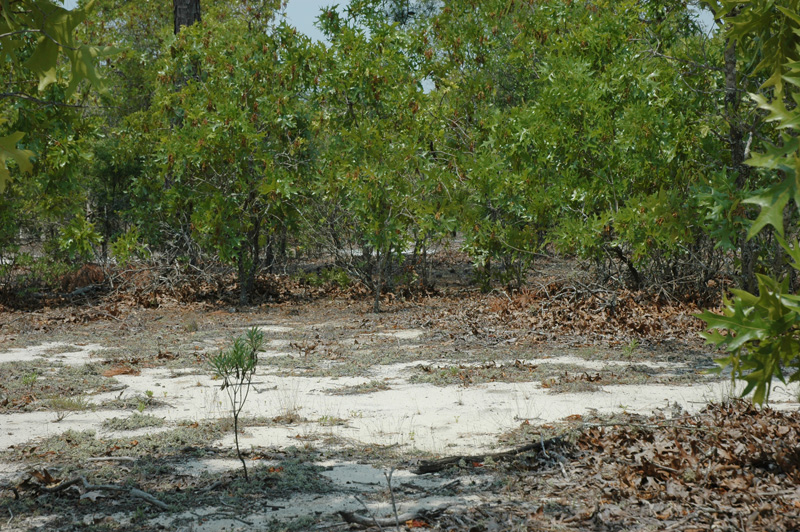
Typical habitat that may be seen at Ohoopee Dunes Natural Area
On our first trip to the Ohoopee, 16-22 June 2002, we collected ants at the south and central natural areas and at the nature preserve. Two of the most dominant and obvious species we observed during the day were Dorymyrmex bureni (Trager) and Forelius pruinosus (Roger). Both of these species are in the subfamily Dolichoderinae and are typical sand nesting species that make somewhat conical mounds above their nests. They are fast moving species that are active during the day. Dorymyrmex bureni is yellowish brown species with a prominent propodeal cone and F. pruinosus is a dark brownish black ant that lacks a cone on the propodeum. An additional species of Dorymyrmex, D. grandulus (Forel), was found in smaller numbers. This species differs from D. bureni in that it is smaller, dark brownish black, and has a reduced propodeal cone, A single specimen of an undescribed species of Forelius was collected along the trail area. This species differs from F. pruinosus by its abundant pilosity on the entire body. One additional dolichoderine species, Dolichoderus mariae Forel, was collected along the edge of the trail. A colony was found beneath a clump of grass in a slightly elevated location. This genus differs from our other southeastern dolichoderines in that the integument is harder and the propodeum is distinctly concave posteriorly (the propodeal declivity is deeply excised). This particular species is bicolored red with most of the gaster dark brownish-black.

The conical mound marking the entrance to a colony of Dorymyrmex bureni
Seven species of ants in the subfamily Formicinae were collected including Lasius americanus Emery, Nylanderia faisonensis (Forel), N. parvula (Mayr), N. phantasma Trager, Camponotus socius Roger, Formica dolosa Buren, and Formica pallidefulva Latreille. Workers of L. alienus were collected in a seepage area near the trail. Workers are average sized and grayish-brown in color. Nylanderia faisonensis was also found in a mesic wooded area. This species, which is typically associated with mesic forests, is widespread in the Southeast. Workers can be recognized by their having mostly uniform brown color, with pale mid and hind coxae; fine, closely spaced, appressed pubescence on the front of the head (above the eyes); and presence of several (usually 7-10) strong erect setae (macrochaetae) on the scapes. Nylanderia parvula workers were collected in pitfalls in the pine-oak woodland. This small, dark-colored species can be separated from others in the genus by its lack of erect hairs on the antennal scapes coupled with its dark coloration. It usually nests in leaf litter. Nylanderia phantasma workers were collected in pitfall traps in the pine-oak dune woodland. This is a small, pale yellow, nocturnal species that has very few erect hairs on the antennal scapes. This collection represents a new state record for Georgia, although we were not surprised to find it in this habitat as we have collected it in similar habitats in other southeastern states. Camponotus socius was found throughout the natural area, although it was most active at night. This is a large distinctive species of carpenter ant and can be identified by its opaque reddish color, except on the gaster, which is dark brownish black with yellow banding. An additional species, Camponotus floridanus (Buckley), was collected at the Nature Conservancy Preserve, which adjoined the south natural area, and therefore, was likely present in natural area as well. This species is easily distinguished from other carpenter ants in this region by its red and black bicolored body coupled with its very hairy appearance. Workers of F. dolosa and F. pallidefulva were both collected in the pine-oak woods, although no colonies were observed. Similar to carpenter ants in size and general appearance, Formica species differ in that the workers possess ocelli. Both species are orangish-red in color, but F. dolosa has more erect hairs on the alitrunk and denser pubescence on the alitrunk and gaster than F. pallidefulva, which is much smoother in appearance with relatively few (if any) erect hairs on the aliltrunk and much more sparse pubescence.
In leaf litter we collected Stigmatomma pallipes (Haldeman), several ponerine ants including Pachycondyla (formerly Cryptopone) gilva (Roger), Hypoponera opacior (Forel), Ponera exotica Smith, and P. pennsylvanica Buckley, and related proceratiine ants Discothyrea testacea Roger, Proceratium crassicorne and P. silaceum. All of these species species are widespread, soil and litter inhabiting ants that have reduced eyes and somewhat atypical appearances for ants. Stigmatomma pallipes, in the Amblyoponinae subfamily, was found in litter beside logs or beneath trees in both the bald and the pine-oak woods. This dark brown species is distinctive with its elongate and bidentate mandibles and its large petiole, which is broadly joined to the gaster. The reddish-brown colored Pachycondyla gilva differs from the other three ponerines collected in that it has two apical spurs on the mid and hind tibia (instead of one), and has an oval pit at the base of the mandible, which is lacking in the other ponerines. Members of the genus Hypoponera differ from those in Ponera by having the subpetiolar process simple, instead of having two posteriorly directed spines and a clear, circular opening anteriorly. Ponera exotica is a minute, yellow colored species that is less frequently collected, and P. pennsylvanica is a dark brownish-black species that is very common and widespread. Discothryea testacea is a minute pale yellow species with tiny eyes and distinctive antennae, which terminate apically in a large, bulbous, single segmented club. The two reddish-brown Proceratium species are similar in appearance, and both have enlarged first and second gastral tergites, which tends to give them (and others in the group) a wingless wasp-like appearance.
Several minute dacetine ants were collected in litter including Strumigenys angulata Smith , P. bunki, S. dietrichi, S. ornata , S. pergandei, S. rostrata, S. wrayi, and S. louisianae . Of these species, S. wrayi , is the most uncommon and is only known from a few localities in the Southeast. Members of this tribe have uniquely modified setae, variable dentition and mandible length, and often possess strange "spongiform tissue, of which the function is not known. These species were all collected from litter samples taken from the pine-oak woodland and in litter in a ravine in mixed woods bordering the open sandy area at the nature preserve. They are very difficult to spot in the field because of their tiny size, brown coloration, and cryptic behavior. It takes a keen eye indeed to find them, although it is somewhat easier if litter is first put into a shallow, light-colored pan for observasion.
Trachymyrmex septentrionalis colonies were extremely abundant along the trail and in open areas in the pine-oak dune woodland. This species makes distinctive cresentic mounds above their underground nests, and are quite easy to spot in the field. Similar to leaf cutting ants, Trachymyrmex get nourishment from their subterranean fungus gardens, which they grow using insect feces and various other plant and animal detritus for a substrate. This species is mostly active during cooler periods of the day from near dusk through early morning, although workers may also be seen foraging during mid-day if temperatures are low or there is sufficient cloud cover.
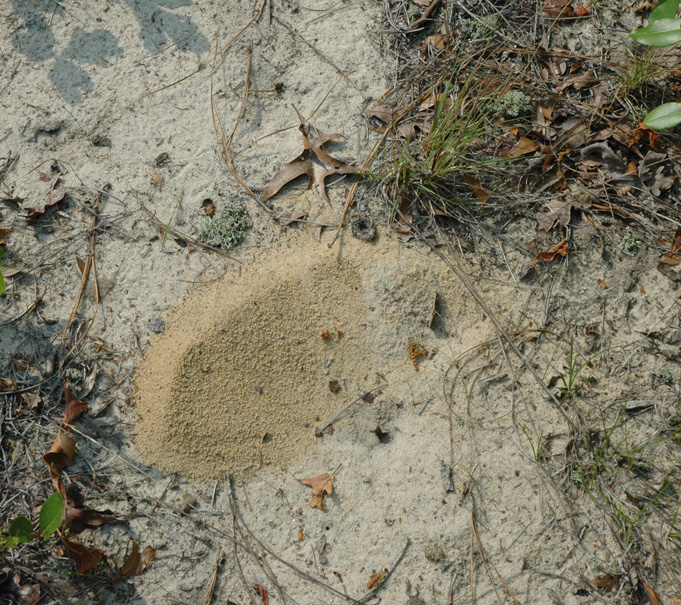
A typical crescent shaped mound above the subterranean nest of Trachymyrmex septentrionalis
Workers of Monomorium viridum Brown were collected in pitfalls in the pine-oak dune woodland. The minute blackish workers are very similar in appearance to workers of Monomorium minimum (Buckley). The best way to differentiate the two species is with queens, which were not collected. Queens of M. minimum are black, whereas queens of M. viridum are bicolored red and greenish-black. A related, and much more notorious species, Solenopsis invicta Buren, was found nesting in soil on the roadside. Fortunately, this exotic species, which may be very abundant in many habitats (especially disturbed ones), was found in limited numbers only near the entrance and along the roadway at Ohoopee. Three native Solenopsis species, S. carolinensis Forel, S. pergandei Forel, and S. tennesseensis Smith, were collected. All three of these species are minute, yellowish ants with reduced eyes that live in soil, of which the latter two nest in sand.
Colonies of Pogonomyrmex badius (Latreille) were found in open sandy areas at both the natural areas and at the nature preserve. This polymorphic species is the only member of the genus found east of the Mississippi River and is only nests in open areas with deep sand. The mounds, which may be 40 cm or more in diameter, and over 3.0 m deep, are often covered with many small pieces of charcoal, seed husks, various pieces of debris, and sometimes small pebbles. Due to the large size and adornment of the mounds, they are very easy to spot in the field. At night workers of this diurnal species closes the entranceways to their subterranean nests. Workers are reddish-brown and range in size from 0.64 to 0.95 cm. Seeds of various grasses and forbs form a large part of the diet of harvester ants, although they supplement their diet with various arthropods. Members of this genus are reputed to have among the most painful sting of any North American ant, and although they are not overly aggressive, special care should be taken to avoid being stung by them. One other member of the same tribe, Myrmica punctiventris was collected at the south natural area. This dark brown myrmicine species is easily separated from P. badius by its color, having only one worker size, long propodeal spines, and predilection for nesting in wooded areas, rather than in open sand.
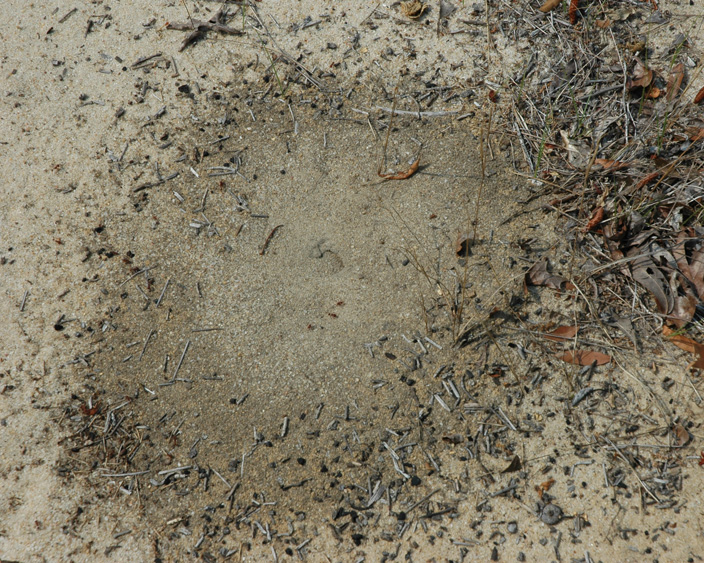
The crater-like mound of Pogonomyrmex badius
Eight species belonging to the tribe Pheidolini (subfamily Myrmicinae) were collected including Aphaenogaster floridana Smith, A. treatae Forel, A. umphreyi Deyrup & Davis, Pheidole adrianoi Naves, P. dentata Mayr, P. dentigula Smith, P. metallescens Emery, and P. morrisi Forel. Workers of Aphaenogaster floridana workers were collected in the pine-oak dune woodland. This species is somewhat atypical for the genus in that it lacks propodeal spines. It is easily distinguished from other eastern species by this feature and by its yellowish-orange coloration and slender elongate body. Aphaenogaster treatae is a dark brown species that is larger than the other two species we collected, has relatively long spines, and is distinctive in that the basal fourth (or more) of the antennal scape is flattened, appearing as a lobe-like structure. Aphaenogaster umphreyi is apparently only found in sandy, scrub type habitat and is a subterranean species. This brown species has elongate propodeal spines that are oriented upward and is very similar to A. fulva, but differs by having much smaller eyes. Pheidole adrianoi is a small black species that is known to occur in habitats with sandy soils. This species does not seem to be extremely widespread and may be confined to select habitats in the coastal plain. Pheidole dentata is a widespread species that nests in a variety of habitats in both soil and rotting wood and may have very large colonies. It is a an average sized species with minor workers about 2.0 mm and majors up to approximately 3.0 mm in length. Color is variable from light reddish-brown to blackish-brown. This species was collected in the oak-pine scrub area and workers were active during both the day and night. Pheidole dentigula is a widespread southeastern species found in a variety of wooded habitats. This species is reddish-brown and both minors and majors have reticulate sculpturing on the alitrunk and occipital region of the head. Pheidole metallescens typically has somewhat small colonies in the soil in sandy areas. It is a smaller species, with major workers only being up to approximately 2.0 mm in length. Major workers are reddish-brown and minors are reddish-brown to blackish with metallic greenish or bluish reflections (in the field minor they usually appear black, metallic reflections can be seen with higher magnification). Entrances to the nests of this species are often no more than a single small hole in the ground with no mound above it or ring of soil, as is seen in other similar species. Pheidole morrisi is a mostly eastern species that appears to be confined to nesting in sandy soils. Nests can be large with hundreds or thousands of workers and are often at the bases of grass clumps or under light leaf litter. However, in the panhandle of Florida we observed this species nesting along roadsides in the sand with relatively large mounds surmounting nests. Workers are similar in size to P. dentata, but differ in that they are pale yellow and lack propodeal spines (present in P. dentata and most other Pheidole species). Interestingly, major workers that we have observed in Florida were much larger than those found at Ohoopee. Specimens were not seen in the field, but were collected in pitfall traps in the pine-oak woodland.
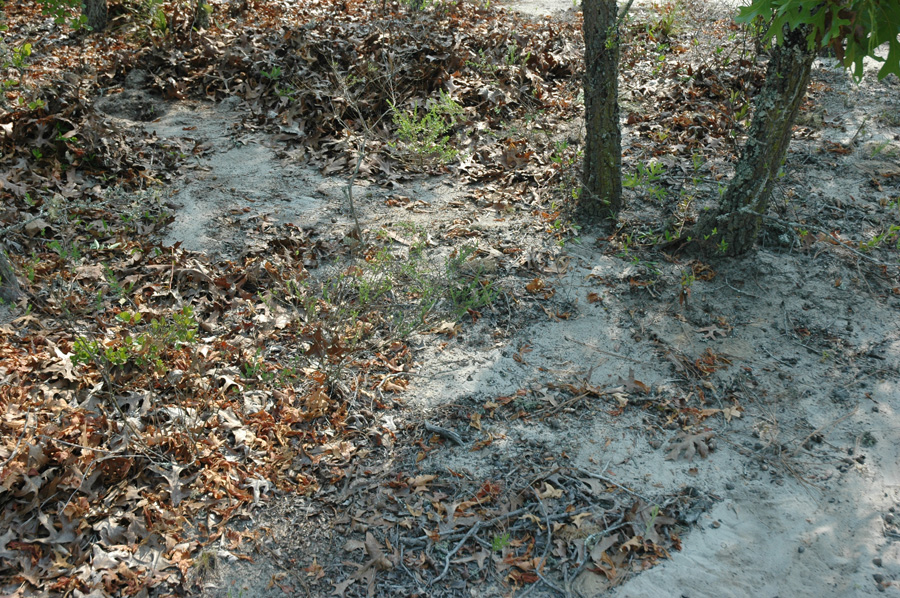
Oak leaf litter in the pine-oak dune woodland
Three species of Crematogaster, C. ashmeadi Mayr, C. lineolata (Say), and C. minutissima (Mayr) were collected. All three of these species are common and widespread. Workers of C. ashmeadi were collected as they crawled on tree trunks along the trail, and C. lineolata workers were collected in pitfall traps in the pine-oak dune woodland. Both of these species are small and brownish-black, but differ in that C. ashmeadi has short propodeal spines and smooth pronotal sides, whereas C. lineolata has somewhat long spines and the pronotal sides are textured with transverse ridges or rugulae. The minute, pale yellow C. minutissima (apply named!), was only collected at the nature preserve. Workers of Temnothorax pergandei (Emery) were collected in litter at the south natural area. This is our largest Temnothorax in the region and can easily be distinguished by its 12 segmented antenna, deep mesonotal constriction, and overall shiny appearance.
Our second visit to the Ohoopee Dunes N.A. was from 15 to 16 May 2007. We arrived at the south natural area at approximately 6:00 P. M. and continued our collecting until approximately 11:00 P.M. We returned early the next morning and collected until mid-afternoon. Our collections were made on the west side of county road 160 along the sand trail/ road that runs north through the pine-oak dune woodland (a lat/long reading in the vicinity was 32°31'51"N82°27'23"W) and north into the "bald" or xeric dune scrub (32°32'15"N82°27'40"W).
As in our first visit, D. bureni and F. pruinosus colonies were abundant, with their numerous workers seen actively foraging during the day. Both male and female alates were present in the F. pruinosus colonies. The females were much larger than the workers and bicolored red and black, whereas the males were slightly smaller than the workers and were grayish is color. However, neither D. grandulus or the new species of Forelius were collected during this trip. Workers of Dolichoderus mariae were again collected, and in approximately the same location as they were found five years earlier. They were observed as they crisscrossed the trail in two columns, each going in opposite directions. We were unable to locate their colony as they made their way into the leaf litter.
Searching through the leaf litter in the wooded area, we discovered colonies of Nylanderia parvula. Nylanderia phantasma was found to be very common in the area. Colonies of this species were found abundant in open sand throughout the area and were marked by a thin ring of sand surrounding a central entrance hole. Workers were not seen during the day, but were very active at night and were observed in great numbers as they crawled on the sand. Males of Camponotus castaneus (Latreille) were collected at a blacklight and sheet setup that we had up until about 11:00 P.M. Workers of this carpenter ant species are large and concolorous orangish-red. This common woodland species typically nests in the soil. A minor worker of Colobopsis impressa Roger was collected in dry litter in the bald. This species, in the subgenus Colobopsis, nests in hollow twigs or other cavities Members of this subgenus are atypical for the genus in that the mesonotal suture is deep and distinct and the head of major workers are severely truncate anteriorly. Somewhat surprisingly, we did not find any specimens of C. socius during this collecting trip, and we thought that perhaps we were slightly early in the year for them.
We again collected Stigmatomma pallipes, in litter beside logs or beneath trees in both the bald and the pine-oak woods, Hypoponera opacior, in litter in both the bald and the pine-oak woods, and Discothryea testacea, in litter. We also collected Proceratium pergandei Emery in litter in the bald. Compared to D. testacea, Proceratium pergandei is much larger, dark brown, and the antenna does not terminate in a bulbous club. This species is rather bizarre looking with the latter segments of its gaster appearing to begin midway beneath the second segment of the gaster.
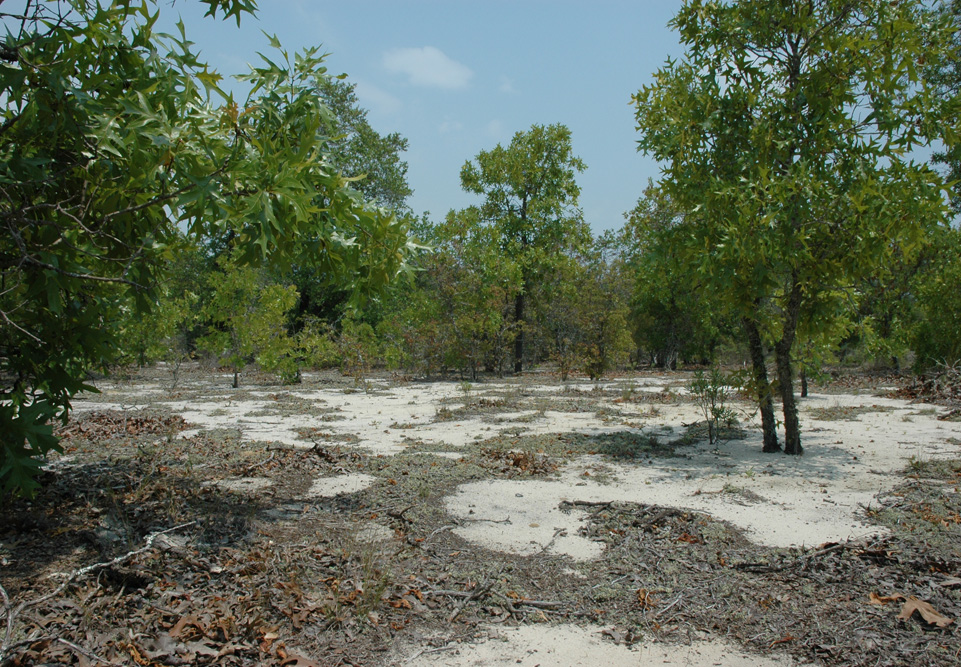
A view of the "bald" or xeric dune scrub
Two new dacetine species, Strumigenys clypeata Roger and S. missouriensis (Smith), were collected for the area, as well as Strumigenys louisianae, which we collected on the first visit. All three of these widely distributed species are minute soil and litter dwelling species. Unlike the first journey to the site, neither Monomorium viridum or Solenopsis invicta were observed. However, Solenopsis carolinensis and S. abdita Thompson were found in litter. Members of the molesta group are very difficult to identify, especially without queens, which are more diagnostic than workers. Workers of these species are very similar to one another, but queens differ in color with those of S. carolinensis being yellow, and those of S. abdita being dark brownish-black. We were fortunate enough to find queens of both species.
As we walked along the trail we observed an abundance of ant mounds of various species in the sand. The largest mounds we saw belonged to Pogonomyrmex badius. Many of these colonies (at least 15 were observed), which were approximately 30 to 40 cm and from 2 to 4 cm high, were located in the middle of the trail, although others were scattered in open areas in the somewhat open oak-pine woodland. It was interesting to see such an abundance of this species as compared with our first visit when we found fewer colonies. Similar to the first visit, colonies of T. septentrionalis colonies were too numerous to count and were scattered throughout the area. When we arrived at the site, workers were not active, but as darkness approached they began to appear from their nests and were very obvious.
Our collecting efforts during this trip again yielded eight Pheidolini, the same number we found in 2002, and included Aphaenogaster carolinensis Wheeler, A. floridana, A. treatae, Pheidole davisi Wheeler, P. dentata, P. dentigula Smith, P. metallescens, and P. morrisi. However, two of these, A. carolinensis and P. davisi, were not collected on the first trip, whereas A. umphreyi and P. adrianoi were not collected on this trip. The first species, A. carolinensis, was found in litter in the pine-oak woods. This is a slender reddish brown species with yellowish legs. Propodeal spines are present, but somewhat reduced, and point posteriorly. A colony of A. floridana, was found along the trail about midway from the beginning (near the road) to the bald. Workers of A. treatae were found as they foraged in the litter covered areas of the bald. The presence of Pheidole davisi was a welcome surprise, as it was a species we had not previously collected and lacked in our museum collection. It was only recently reported for the first time from Georgia (Graham et al. 2004) from sandhill habitat at Fort Benning, where they only found a few specimens. Despite its scarcity in many localities, it was quite common here and we noted many colonies along the sandy trail that bisected the area and observed many minor workers as they foraged during the day. Although minors were relatively easy to come by, the majors were another matter, and it took significant effort (and digging) to find even a few. The minors are almost black and very small (similar in size to P. adrianoi and P. metallescens), and majors are reddish-brown and also similar in size to majors of P. adrianoi and P. metallescens. Colonies of P. dentata, P. dentigula, P. metallescens,and P. morrisi were found nesting in the soil in the bald and the pine-oak woods. Although both P. dentata, P. dentigula, and P. metallescens were active during the day, P. morrisi was mostly active at night. Nests of this species were extremely difficult to find and were typically hidden beneath leaf litter.
Two species of Crematogaster, C. ashmeadi and C. cerasi (Fitch) were found, although C. lineolata, which was collected on the first visit was not seen on this trip. Workers of C. ashmeadi were found crawling on vegetation along the trail, and C. cerasi was only collected on plants in the bald. These two species are similar in appearance, but C. ashmeadi has shorter propodeal spines and the sides of the pronotum are smooth, whereas C. cerasi has longer spines with the sides of the pronotum being roughened.
We collected Temnothorax curvispinosus Mayr and T. schaumii Roger along the trail area. Both of these species are widespread and common in the Southeast. Workers of T. curvispinosus were collected in litter in the pine-oak forest. This species is small, yellow, and has elongate spines. This species typically nests in cavities. Only one individual of T. schaumii was collected as it foraged at peanut butter bait on an oak tree. This species is small, dark brown, and has very reduced propodeal spines. It is a cryptic species that is difficult to collect without bait, but is generally easy to find by spreading peanut butter spread on oaks. Colonies are found under bark.
Myrmecina americana Emery, a ubiquitous woodland species, was found in litter in the pine-oak forest. This black species (occasionally reddish) is easily distinguished by its characteristic sharp carina found along the ventrolateral margin of the head, sessile petiole, and bispinose propodeum.
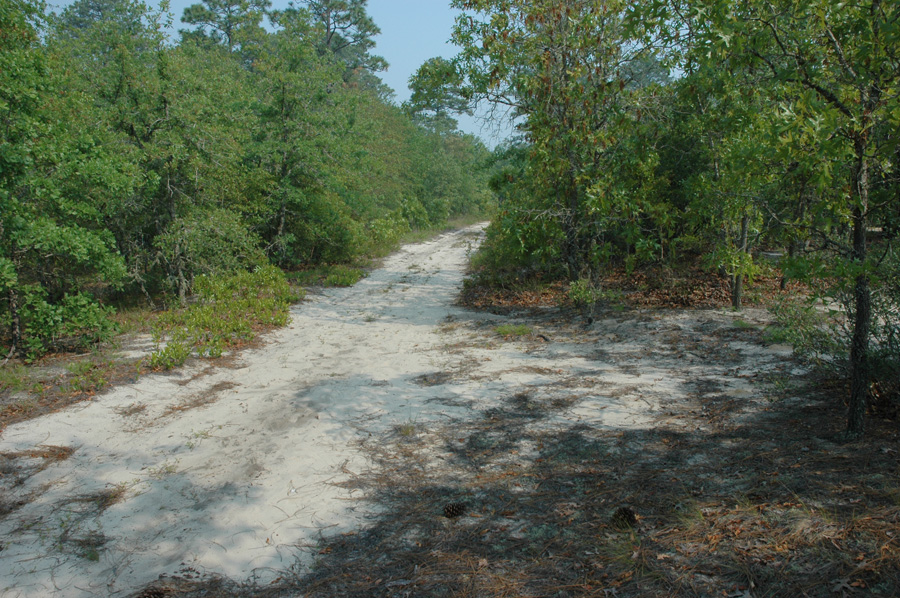
The trail that winds its way through the south natural area
We again returned to the Ohoopee Dunes N.A. on 17 July 2007, arriving at approximately 4:00 P.M. and concentrating our efforts on two sites in the south natural area where we had collected on the previous trip. One obvious difference between this trip and the last one, was the temperature, which was near 100° F. Collecting ants in mid July in sand dune habitats borders on insanity, but fortunately, we had several gallons of water! Otherwise, things were very much as they were on the previous trip, at least ant-wise. The same species that dominated the open sandhill landscape during daylight hours on the two previous trips were again present including D. bureni, F. pruinosus, P. badius, and Ph. davisi. Alate females of F. pruinosus were still present in the colonies. Dolichoderus mariae workers were apparently more common than on our previous visit, and we observed large numbers of them foraging in columns that crossed open areas from one leaf litter strewn area to another. One large colony of this species was located beneath a rotting log in oak litter. Although we didn't stay at the site after dark on this visit, we also observed the very abundant colonies of N. phantasma and T. septentrionalis that dotted the landscape, both of whose workers are nocturnal, and were not seen during the daytime (for the most part). A colony of N. phantasma was excavated to a depth of approximately 0.7 m, but the main portion of the nest was not found, and only a few workers were collected. Similarly, several colonies of Ph. davisi were also excavated to a comparable depth in an effort to collect more major workers, but even at that depth, few majors were found. This either indicates that the main portion of the nest was deeper or that colony size is relatively small with few majors present proportional to the minors. Minors were very easy to find and were observed crawling on the ground throughout the area. Looking in the litter, we again found an abundance of Ph. dentata and to a lesser extent, Ph. morrisi. A couple colonies of Ph. morrisi were found, both with irregular mounds of sand surmounting the colony. Two species of Crematogaster, C. cerasi and C. lineolata, were found to be common in the area and were seen on the ground and crawling on trees and vegetation. A colony of C. lineolata with alate males was found in a rotting oak branch. Monomorium viridum workers were collected on vegetation while beating. Otherwise, no colonies of this species were found. Many other species collected during the past trips were also collected on this trip as well including Lasius alienus, Nylanderia parvula, Hypoponera opacior, Strumigenys louisianae, Aphaenogaster carolinensis, and Solenopsis carolinensis, all of which were found while searching through leaf litter.
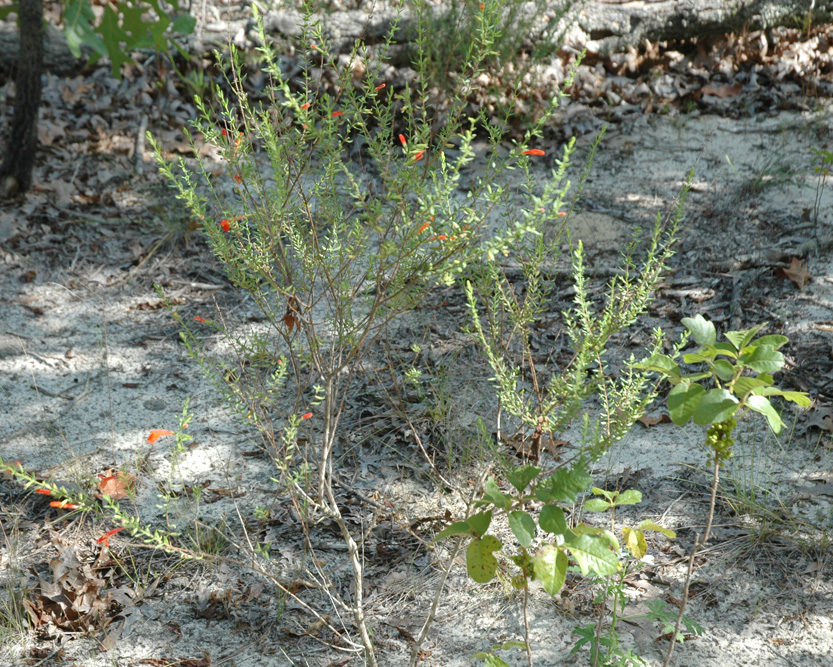
Calamintha coccinea, almost done flowering
Four species collected at the site, which were not collected on the first two trips, included Dolichoderus pustulatus Mayr, Brachymyrmex depilis Emery, Formica biophilica Trager, and Temnothorax texanus (Wheeler). One worker of Dolichoderus pustulatus was collected while speeping Chrysoma in the Bald area. This specis is similar in appearance to D. mariae, but can be easily differentiated by the abundant pilosity on the body, which is mostly lacking in D. mariae. Bracymyrmex depilis was collected while sifting leaf litter. This relatively common woodland species can be distinguished by its minute size, pale yellow coloration, and nine-segmented antennae. Formica biophilica workers were captured as they foraged on the ground, but no colonies were found. This large orangish-brown species was only recently described by Trager (2007). Workers of T. texanus were found crawling on the ground in leaf litter. This dark brown species has 12 segmented antennae, and is relatively small, with noticeable sculpture over much of the body. We also collected workers of the related T. pergandei on the woody goldenrod (Chrysoma pauciflosculosa).
While we were at the site, we observed an abundance of the small tiger beetle, Cicindela abdominalis, as it flew short distances away from us on the trail. We also collected a few more specimens of what appear to be new species of Mydas fly and the recently described day flying geometrid moth, Narraga georgiana. After collecting for about 3 hours, we quit for the day and headed to Swainsboro to eat and sleep.
We headed out the next morning, 18 July, to the north natural area (32°36'16"N82°25'30"W) where we collected until approximately 1:00 P.M. By the time we got to the site, which was near 9:30 A.M., it was already over 90° F and steadily warming up. The habitat at this site was similar to the pine-oak dune woodland at the south natural area, but with less understory and more large longleaf pines present. The area was not as extensive, and it was not a far walk down the trail before a pine forest was encountered. The western border, which was only a few meters west of the trail, sloped down to a more dense wet, wooded area. We mostly confined our collections to the trail and the large open pine-oak forest.
As we parked at the front gate of the natural area, we immediately noticed several colonies of Solenopsis invicta, and were a bit concerned that the area may be more disturbed than the south natural area. Fortunately, the fire ant colonies appeared to be restricted to the entrance area and along the highway, and we did not see any in the natural area itself. Several colonies of Dorymyrmex smithi, a new addition to the list of ants for the area, were also found in the open sandy, entrance area. Similar to the fire ants, colonies of D. smithi appeared to restricted to the entrance area and were not found in the more natural areas. Dorymyrmex smithi nests in similar habitats as D. bureni, and is thought that D. smithi is a temporary parasite of D. bureni. It is not unusual to find these species nesting together, or occasionally, even in the same colony (Trager, 1988). The two are very different in appearance as D. smithi is reddish-brown to brownish-black and has an angular mesonotal profile with distinct dorsal and declivous faces, whereas D. bureni is typically yellow to yellowish-brown and has an evenly convex mesonotal profile without an obvious declivity posteriorly. Some taxonomists refer to D. smithi as D. medeis Trager, although this name was synonymized by Snelling in 1995. This group shows much in the way of variation, and it is likely that it will receive further taxonomic work in the future. Colonies of Dorymyrmex bureni were abundant throughout the natural area, and workers were among the most noticeable ants found in the natural area. We found colonies of Forelius pruinosus and Nylanderia phantasma in similar abundance to D. bureni in the open sandy areas. However, only the Dorymyrmex and Forelius were active, as N. phantasma is nocturnal. Workers of Nylanderia parvula were found in areas with some litter accumulation, although no colonies were discovered. The widespread N. vividula was collected along the western edge of the dune area in slightly damp, sloped area. Although this is a common species in the Southeast, this represented the first collection of it at Ohoopee.
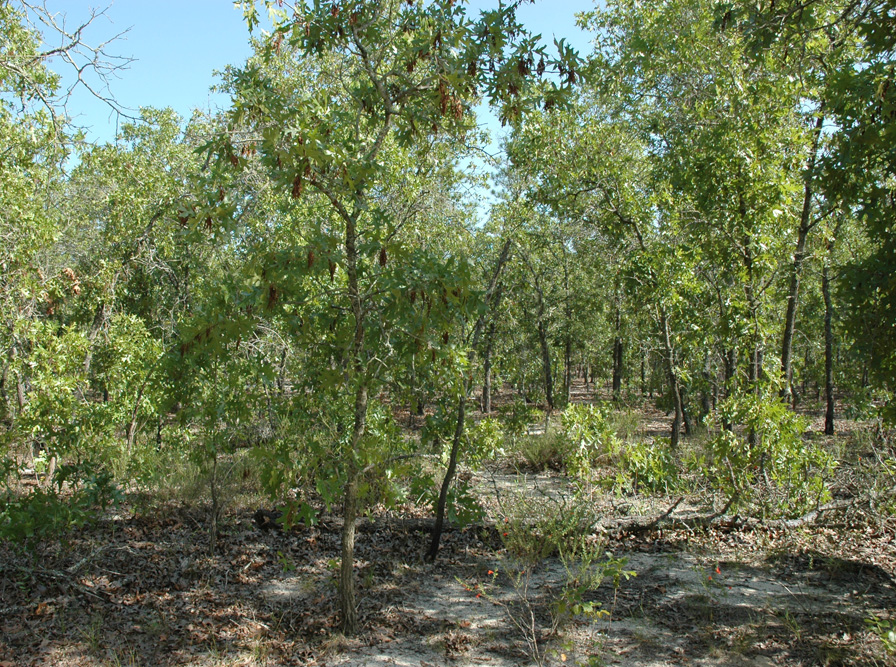
A view of the dune woodland at the north natural area.
Colonies of Pogonomyrmex badius were found throughout the dune woodland in open sandy spots, including the area near the entrance. As is typical for this species, colonies were spread out with none of them being very near one another, as workers may forage many meters from the colony. Similar to other sites at Ohoopee, numerous colonies of T. septentrionalis were in evidence. Unlike Pogonomyrmex, this species seems to have no compunction about nesting near fellow conspecifics. Although this species is typically nocturnal and we did not observe any worker activity, dealate queens were seen crawling on the ground, presumably looking for nest sites.
Pheidole davisi colonies (and foraging workers) were extremely abundant in the open sandy areas of the pine-oak dune woodland. If one was not looking specifically for this species, it could be easily overlooked due to its minute size and somewhat cryptic nests. Although the minors of P. davisi were common, it was again difficult to collect majors. By using cookie crumbs for bait, which the minor workers responded to, workers were followed to their colonies. Their nests were subterranean and only marked by a small entrance hole approximately 2 mm in diameter and with a very thin, partial ring of sand around it. Placing a few bits of the cookie bait near the entrance enticed some major workers to emerge. After several minutes, and with many ants, albeit, mostly minors, at the bait, the colony was excavated to a depth of approximately 1.0 m. Excavate is probably a strong word, because when digging into pure sand, the integrity of the colony is mostly destroyed. However, as it was "excavated", portions of the colony were placed into a pan and perused for ants. Despite the depth that the colony was excavated, few additional majors were collected. A large colony of Pheidole morrisi was found in a low sand bank. Digging into the colony resulted in the finding of alate males, some of which were collected, along with workers. Workers of the minute yellow P. bilimeki Mayr were found crawling on the ground beneath leaf litter, although no colonies were seen. This represented a new find for the natural area.
In shady areas beneath trees and with a thin layer of leaf litter, workers of A. floridana were found as they foraged. Several colonies were located by following workers that had taken cookie bait, and the colonies were only marked by a small entrance hole that was not much bigger than the girth of an ant. In one case, the entrance was hidden beneath a small leaf. Similar to P. davisi, excavations of up to one meter resulted in the finding of relatively few workers. Interestingly, the workers collected here, and at other sites at the Ohoopee N.A., were smaller, more shiny, and lighter in color than workers collected at Big Hammock N.A. in Tattnall County, another similar sand dune habitat. A few workers of Aphaenogaster ashmeadi Emery, another new record for Ohoopee, and A. treatae were collected as they foraged. These two species are very similar to one another as they both possess distinctive basal lobes on the antennal scapes. They can be distinguished from each other by the shape and length of the lobe (much smaller in A. ashmeadi). One additional species of Aphaenogaster, A. carolinensis was found along the western edge of the dune area in slightly damp, sloped wooded area.
A large colony of Crematogaster lineolata was found nesting in a rotting branch of turkey oak on the ground. Workers of this widespread species were seen in abundance as they foraged along the litter strewn pine-oak dune woodland. Workers were also observed feeding on an in dead Polyphylla donaldsoni Skelley (Scarabaeidae), a recently described species that is apparently endemic to this area. Peeling back the bark on longleaf pine trees revealed the presence of another Crematogaster species, C. pinicola Deyrup and Cover, which is most similar to C. ashmeadi. This species was observed on all pines that were examined and they appeared to be quite abundant.
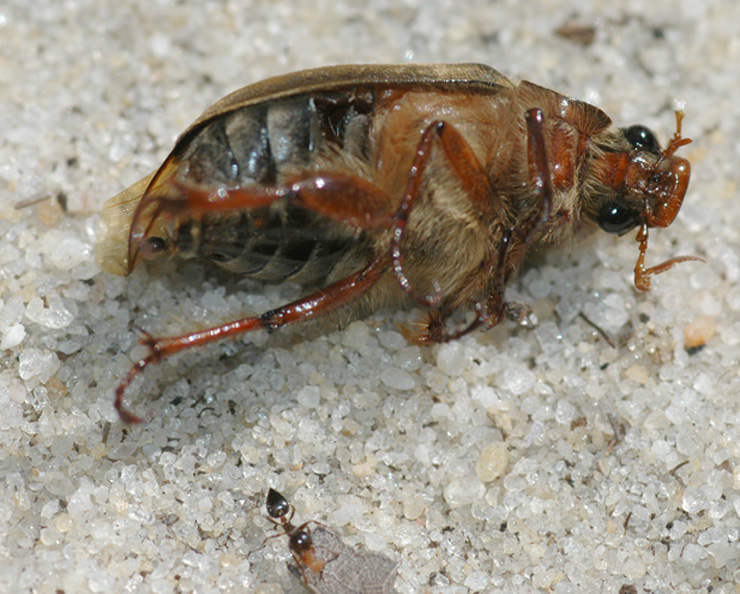
A Crematogaster worker walking away with part of a dead Polyphylla donaldsoni
Temnothorax smithi (Baroni Urbani), was also found nesting in bark in large longleaf pines. This reddish-brown, highly sculptured species is uncommonly collected and we were excited to find it nesting here. Temnothorax pergandei workers were collected on the ground in litter and on vegetation, and T. texanus workers were found on the ground in litter. Three other species were found in the leaf litter including Hypoponera opacior, Strumigenys louisianae, and Solenopsis carolinensis, all of which were also found at the south natural area.
Another visit was made to the Ohoopee Dunes area from 5 through 10 October 2007 when we collected at the north, central, and south natural areas and the nature preserve. This particular trip also served as our annual William H. Cross Expedition for this year, with other collectors along as well (see 2007 Cross Log).
Similar to previous collecting trips, the same common sand inhabiting ants, such as Dorymyrmex bureni, Forelius pruinosus, Trachymyrmex septentrionalis, Pogonomyrmex badius, Aphaenogaster floridana, Pheidole davisi, and P. morrisi were again common and abundant. Nylanderia parvula and Pheidole dentata were again abundant in leaf litter. Workers of Nylanderia phantasma, which are typically nocturnal, were seen crawling on the sand under the cloudy sky during the day. Searching under a rotting log at the south natural area revealed a colony of army ants, Neivamyrmex opacithorax, which was a new find for the area. The colony was in the soil, litter, and log and occupied a large area, appearing to follow the log for at least three meters. Although these ants are not overly aggressive, they definitely can inflict a painful sting, as I (MacGown) can now attest! We also collected 6 gallons of leaf litter from the pine-oak dune woodland in the same area, to be run through Winkler extraction sacks back at the cabin. Although plenty of species of ants were extracted from the litter, only one new species for Ohoopee was found, which was Strumigenys talpa Weber . Workers of Aphaenogaster fulva Roger, another new record for the area, were collected in litter during the day at the central natural area. Alate females of an additional new record for the area, Tetramorium bicarinatum (Nylander), were collected at blacklight at the nature preserve. Otherwise, all the ants collected on this trip had already been collected on previous trips. However, we did find alates of several species including males of Crematogaster lineolata in a rotting pine branch; males of Camponotus floridanus at blacklight at the nature preserve; males and queens of Brachymyrmex patagonicus at blacklight at the nature preserve; queens of Forelius pruinosus, B. depilis, and what we thought were queens of Nylanderia phantasma, all collected at blacklight in the north natural area; queens of Hypoponera opacior at blacklight at the nature preserve; and queens of Cyphomyrmex rimosus in a malaise trap at the Bald at the south natural area. Collections of alate males and females are important as they give us information about the ants' reproductive cycles.
Hill visited the relatively new Covena tract of the Ohoopee Dunes Natural Area in Emanuel County on 21 July 2008. At approximately 190 acres, the Covena tract is the smallest of the four natural area sites in Emanuel County. It is located approximately 8 miles southwest of Swainsboro on Statecoach Road, off of Hwy 56. Strumigenys membranifera was the only new species collected for the natural area, and only one dealate queen was found. The apparent disturbance specialists D.smithi and S. invicta were common along a powerline cut, but were not found in the natural habitat.
A total of 78 species of ants (see species list below) were collected at the Ohoopee sites (including those species collected at the adjoining nature preserve). Additionally collecting would probably add more species as several common species that likely occur there were not collected. Twenty-one species apparently restricted to or commonly found in sandy habitats were collected including Dolichoderus mariae, Dorymyrmex bureni, D. grandulus, D. smithi, Forelius pruinosus, F. n. species, Nylanderia phantasma, Camponotus floridanus (nature preserve), C. socius, Monomorium viridum, Solenopsis abdita, S. pergandei, S. tennesseensis, Pogonomyrmex badius, Aphaenogaster floridana, A. umphreyi, Pheidole adrianoi, P. davisi, P. bilimeki, P. metallescens, and P. morrisi. The undescribed species of Forelius and Nylanderia phantasma represent new state records for Georgia. Several other species are only rarely collected including Discothryea testacea, Strumigenys wrayi , Pheidole davisi, and Temnothorax smithi. Other species collected are generally widespread and may found in a variety of wooded habitats. Compared to the number of native species collected, very few exotics were found, including only Brachymyrmex patagonicus, Nylanderia vividula (possibly native), Strumigenys membranifera , Solenopsis invicta, and Tetramorium bicarinatum. Fortunately, none of these species were common with N. vividula only being along the edge of the sandhill habitat in the north natural area and not obviously abundant; C. rimosus queens were collected in a malaise trap, but otherwise few workers were collected; S. invicta only being found along the edge of the sandhill habitat on the roadside and not seen within the habitat itself; and only alates of B. patagonicus and T. bicarinatum collected at lights. Compared to the other two sandhill habitats in Georgia that we surveyed for ants, the Fall Line Sandhills N.A. in Taylor County where we found 33 species, and Big Hammock N.A. in Tattnall County where we found 25 species, the 77 species collected at Ohoopee was by far the highest. However, this difference was not surprising as the the Ohoopee site is a much more extensive sandhill habitat and we made more collections there. There were some obvious affinities between Ohoopee and the other two natural areas. Ohoopee had 15 species in common with the Fall Line Sandhills N. A. that were not collected at Big Hammock including D. bureni, D. smithi, B. depilis, B. patagonicus, F. dolosa, F. pallidefulva, P. pennsylvanica, Py. rostrata, S. louisianae, P. badius, A. carolinensis, A. fulva, P. dentigula, C. pinicola, and T. curvispinosus. Ohoopee and Big Hammock shared 12 species of ants that were not collected at the Fall Line Sandhills N. A. including N. parvula, N. phantasma, C. castaneus, C. socius, M. viridum, A. treatae, P. bilimeki, P. morrisi, C. ashmeadi, C. lineolata, T. pergandei, and T. texanus. All three sites (Ohoopee, Fall Line Sandhills, and Big Hammock) shared the following species: F. pruinosus, H. opacior, S. ornata, C. rimosus, T. septentrionalis, S. carolinensis, S. invicta, S. pergandei, A. floridana, P. adrianoi, P. dentata, and M. americana. To compare the species of ants from Fall Line Sandhills to other localities with similar habitats, click on the links below under the heading "links to ants of other sandhill or sand dune habitats".
To compare the species of ants from Ohoopee Dunes to other localities with similar habitats, click on the links below under the heading "links to ants of other sandhill or sand dune habitats".
Formicidae List -arranged alphabetically by genus
Aphaenogaster ashmeadi Emery (NNA, SNA, Covena)
Aphaenogaster carolinensis Wheeler (NNA, SNA)
Aphaenogaster floridana Smith (NNA, SNA, Preserve)
Aphaenogaster fulva Roger (CNA)
Aphaenogaster treatae Forel (NNA, SNA)
Aphaenogaster umphreyi Deyrup & Davis (SNA)
Brachymyrmex depilis Emery (NNA, SNA, Covena)
Brachymyrmex patagonicus Mayr (NNA, Covena, Preserve) (exotic)
Camponotus castaneus (Latreille) (SNA)
Camponotus floridanus (Buckley) ( Preserve)
Camponotus socius Roger (CNA, NNA, SNA, Covena)
Colobopsis impressa Roger (SNA)
Crematogaster ashmeadi Mayr (NNA, SNA)
Crematogaster cerasi (Fitch) (NNA, SNA)
Crematogaster lineolata (Say) (NNA, SNA, Covena)
Crematogaster minutissima (Mayr) (Covena, Preserve)
Crematogaster pinicola (NNA, SNA, Covena)
Cryptopone gilva (Roger) (Preserve)
Cyphomyrmex rimosus (Spinola)(NNA, SNA)
Discothyrea testacea Roger (SNA)
Dolichoderus mariae Forel (SNA)
Dolichoderus pustulatus Mayr (SNA)
Dorymyrmex bureni (Trager) (CNA, NNA, SNA, Covena, Preserve)
Dorymyrmex grandulus (Forel) (CNA, SNA)
Dorymyrmex smithi Cole(NNA, Covena)
Forelius pruinosus (Roger) (CNA, NNA, SNA, Covena, Preserve)
Forelius n. sp. (new state record) (SNA)
Formica biophilica Trager (SNA)
Formica dolosa Buren (SNA, Covena)
Formica pallidefulva Latreille (NNA)
Hypoponera opacior (Forel) CNA, NNA, SNA, Covena, Preserve)
Lasius americanus Emery (SNA)
Monomorium viridum Brown (SNA, Covena)
Myrmica punctiventris Roger (SNA)
Myrmecina americana Emery (SNA, Covena)
Neivamyrmex opacithorax (Emery) (SNA)
Nylanderia faisonensis (Forel) (SNA)
Nylanderia parvula (Mayr) (CNA, NNA, SNA, Covena)
Nylanderia phantasma (Trager) (new state record) (CNA, NNA, SNA, Preserve)
Nylanderia vividula (Nylander) (NNA) (possibly exotic)
Pheidole adrianoi Naves (SNA)
Pheidole bilimeki Mayr(NNA) (originally reported as P. floridana)
Pheidole davisi Wheeler (CNA,NNA, SNA)
Pheidole dentata Mayr (CNA, NNA, SNA, Covena, Preserve)
Pheidole dentigula Smith (SNA)
Pheidole metallescens Emery (CNA, SNA, Covena)
Pheidole morrisi Forel (CNA, NNA, SNA, Preserve)
Pogonomyrmex badius (Latreille) (NNA, SNA, Covena)
Ponera exotica Smith (Preserve)
Ponera pennsylvanica Buckley (Preserve)
Proceratium crassicorne Emery (Preserve)
Proceratium pergandei (Emery) (SNA)
Proceratium silaceum Roger (CNA, SNA)
Solenopsis abdita Thompson (SNA, Covena)
Solenopsis carolinensis Forel (CNA, NNA, SNA, Covena)
Solenopsis invicta Buren (Exotic) (NNA, SNA, Covena-only along roads bisecting sites, or at entrances) (exotic)
Solenopsis pergandei Forel (SNA)
Solenopsis tennesseensis Smith (SNA)
Stigmatomma pallipes (Haldeman) (SNA, Covena)
Strumigenys angulata Smith (SNA)
Strumigenys bunki (Brown) (SNA)
Strumigenys clypeata Roger (SNA)
Strumigenys dietrichi Smith (Covena, Preserve)
Strumigenys louisianae Roger (NNA, SNA, Covena)
Strumigenys membranifera Emery (Covena)
Strumigenys missouriensis Smith (SNA)
Strumigenys ornata Mayr (Preserve)
Strumigenys pergandei Emery (Preserve)
Strumigenys rostrata Emery (SNA)
Strumigenys talpa Weber(SNA)
Strumigenys wrayi (Brown) (Preserve)
Temnothorax curvispinosus Mayr (SNA)
Temnothorax pergandei (Emery) (CNA, NNA, SNA, Covena)
Temnothorax schaumii Roger
(SNA)
Temnothorax smithi (Baroni Urbani) (NNA)
Temnothorax texanus (Wheeler) (NNA,SNA)
Tetramorium bicarinatum (Nylander) (Preserve) (exotic)
Trachymyrmex septentrionalis (McCook) (CNA, NNA, SNA, Covena, Preserve)
Links to ants of other sandhill or sand dune habitats
Ants of Deaton Preserve, Greene County, Mississippi
Ants of Horn Island, Jackson County, Mississippi
Ants of Palestinian Gardens, George County, Mississippi
Ants of Bon Secour National Wildlife Refuge, Baldwin County, Alabama
Ants of Fall Line Sandhills Natural Area, Taylor County, Georgia
Ants of Big Hammock Natural Area, Tattnall County, Georgia
Sites
Ohoopee Dunes Natural Area Sites
North Natural Area - Trail and open woodland (Site 1)
GA.,Emanuel Co.
Ohoopee Dunes N.A.
32°34'31"N82°26'30"W
pine-oak dune woodland
Central Natural Area - Trail and open woodland (Site 2)
GA.,Emanuel Co.
Ohoopee Dunes N.A.
32°34'32"N82°26'33"W
pine-oak dune woodland
South Natural Area Loop road and north side of road - Trail and woods surround it (Site 3)
GA., Emanuel Co.
Ohoopee Dunes N.A.
32°31'51"N82°27'23"W
pine-oak dune woodland
South Natural Area - Bald (also part of Site 3)
GA., Emanuel Co.
Ohoopee Dunes N.A.
32°32'15"N82°27'40"W
xeric dune scrub
Covena Tract (Site 4)
GA.,Emanuel Co.
Ohoopee Dunes N.A.
32°29'23"N82°24'41"W
pine-oak dune woodland
Ohoopee Dunes, Nature Conservancy Site (Site 5)
GA., Emanuel Co.
Ohoopee Dunes Pres.
32°31'17"N82°26'42"W
pine-oak dune woodland
Acknowledgments
This research was conducted with support from the Mississippi Entomological Museum, the Georgia Department of Natural Resources, the William H. Cross Expedition Fund, and the USDA-ARS Areawide Management of Imported Fire Ant Project (Richard L. Brown, Principal Investigator).
Graham, J. H., H. H. Hughie, S. Jones, K. Wrinn, A. J. Krzysik, J. J. Duda, D. C. Freeman, J. M. Emlen, J. C. Zak, D. A. Kovacic, C. Chamberlin-Graham, and H. Balbach. 2004. Habitat disturbance and the diversity and abundance of ants (Formicidae) in the southeastern fall-line sandhills. Journal of Insect Science 4: 30, 15 pp.
Ipser, R. M., M. A. Brinkman, W. A. Gardner, and H. B. Peeler. 2004. A survey of the ground-dwelling ants (Hymenoptera: Formicidae) in Georgia. Florida Entomologist 87: 253-260.
Lubertazzi, D. and W. Tschinkel. 2003. Ant community change across a ground vegetation gradient in north Florida's longleaf pine flatwoods. Journal of Insect Science 3: (21) 17 pp.
Snelling, R. R. 1995. Systematics of Nearctic ants of the genus Dorymyrmex (Hymenoptera: Formicidae). Contr. Sci. (Los Angel.). 454: 1-14.
Trager, J. C. 1988. A revision of the Conomyrma (Hymenoptera: Formicidae) from the southeastern United States, especially Florida, with keys to the species. Florida Entomologist 71: 11-29.
Trager, J. C., J. A. MacGown and M. D. Trager. 2007. Revision of the Nearctic endemic Formica pallidefulva group (Hymenoptera: Formicidae: Formicinae). In: Snelling, R. R., P. S. Ward, and B. L. Fisher (editors), Advances in ant systematics. Memoirs of the American Entomological Institute 80: 610-636.
Van Pelt, A. F. Jr. 1956. The ecology of the ants of the Wellaka reserve, Florida (Hymenoptera: Formicidae). The American Midland Naturalist 59: 1-57.


